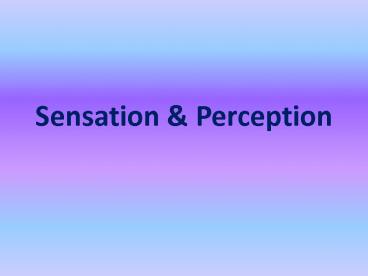Sensation - PowerPoint PPT Presentation
1 / 22
Title:
Sensation
Description:
Sensation & Perception Sensation: Process by which our sensory receptors and nervous system receive stimuli from the environment Perception: Process of organizing and ... – PowerPoint PPT presentation
Number of Views:154
Avg rating:3.0/5.0
Title: Sensation
1
Sensation Perception
2
Whats the Difference?
Sensation Process by which our sensory
receptors and nervous system receive stimuli from
the environment Perception Process of
organizing and interpreting sensory information,
enabling us to recognize meaningful objects and
events
3
Sensation vs. Perception
4
- Psychologists distinguish between two types of
processes in perception - Bottom-up processing perception begins with the
stimulus itself - 2. Top-down processing refers to the use of
contextual information in pattern recognition
5
Richard Gregory, 1970s Top-down Processing
- Perception involves a lot of hypothesis testing
to make sense of the information presented to the
sense organs. - Our perceptions of the world are hypotheses based
on past experiences and stored information. - The formation of incorrect hypotheses will lead
to errors of perception.
6
This object appears to flip between orientations
because the brain develops two equally plausible
hypotheses and is unable to decide between them.
7
8
Lets Take a Look at Charlie Chaplin
Charlie Chaplin's Face
9
What's Up?!
10
Psychophysics
- Study of the relationship between the physical
characteristics of stimuli and our psychological
experience of them.
11
Absolute Threshold
- Minimum stimulation necessary to detect a
particular stimulus 50 of the time - Absolute thresholds vary with
- Our age
- Our psychological state
12
Signal Detection Theory
- Tries to predict when we will react to a weak
signal (stimulus) - Whether we will detect a weak stimulus depends on
motivation, expectations, and experience - Examples
- Mom of a newborn
- Soldier in combat
- Someone who plays video games
13
What is a subliminal stimulus?
- A stimulus that is detectable LESS than 50 of
the time. - They are below absolute threshold.
- Helps account for those times when we feel what
we cant put words to (intuition?)
An Advertising Campaign
14
Who eats Skittles Anyways?
15
Are Your Thirsty?
16
A Nice Picture in a Childrens Book
17
The Big Message
- Much of our information processing occurs
automatically, out of sight, off the radar screen
of our conscious mind.
18
Difference Thresholds
- Just Noticeable Difference
- Minimum difference a person can detect between
any to stimuli 50 the time - The detectable difference increases with the size
of the stimulus
19
Weber-Fechners Law
- For people to really perceive a difference, the
stimuli must differ by a constant "proportion"
not a constant "amount"
20
Sensory Adaptation
21
Is There Visual Adaptation?
Sensory Adaptation Activity
22
(No Transcript)































